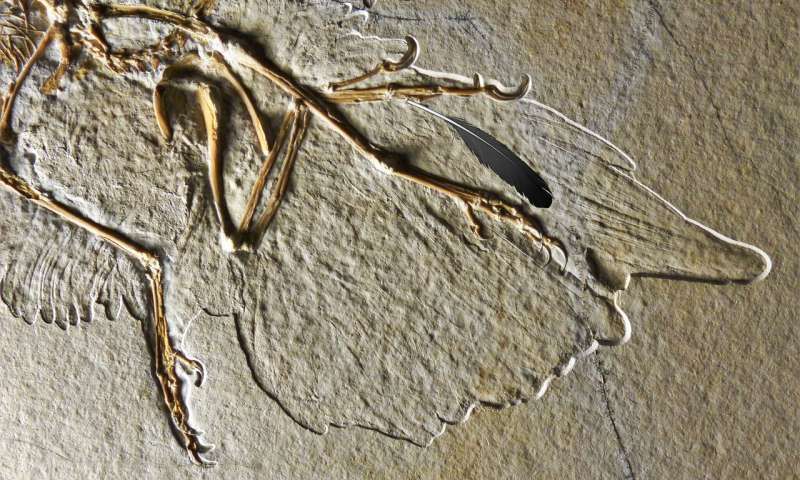New Study Reignites Debate Over Which Species Shed the First Fossil Feather Ever Found
Initially discovered in the 1800s, researchers argue that the 150-million-year-old plume came from the fluttering dinosaur Archaeopteryx
:focal(1266x1038:1267x1039)/https://tf-cmsv2-smithsonianmag-media.s3.amazonaws.com/filer/2a/48/2a4860e5-8d8e-460b-b2f2-8254f5f18342/2-dinosaurfeat_1.jpg)
New research may settle a decades-long debate about the true owner of a 150-million-year-old fossilized feather, reports Lucas Joel for the New York Times. Found in a German limestone quarry in 1861, this solitary piece of mineralized plumage was the first fossil feather ever discovered.
Since then, paleontologists have argued over whether or not the feather belongs to Archaeopteryx lithographica, a small dinosaur that, with its combination of sharp teeth, feathered wings and hollow bones, is a famous evolutionary forebear to modern birds.
The issue is that the feather was discovered sans skeleton, leaving the question of its donor’s identity unsettled for some, though many assert that the historic fossil likely came from the wing of an Archaeopteryx. In 2019, a notable paper forcefully argued that the feather did not come from Archaeopteryx at all, reports Michael Greshko for National Geographic. Now, a new piece of research, published this week in the journal Scientific Reports, claims to settle the debate in favor of the feather belonging to Archaeopteryx.
"There's been debate for the past 159 years as to whether or not this feather belongs to the same species as the Archaeopteryx skeletons, as well as where on the body it came from and its original color," says Ryan Carney, a paleontologist at the University of South Florida who led the new research, in a statement. "Through scientific detective work that combined new techniques with old fossils and literature, we were able to finally solve these centuries-old mysteries."

Carney and his co-authors say the feather’s shape and location dovetail with the idea that it was loosed from an Archaeopteryx wing. The team compared the lone feather with others that were still attached to Archaeopteryx skeletons. They found it had a similar length, width and curvature, according to the Times.
With the help of digital renderings of fossil specimens and the feather itself, the researchers were able to slot the feather’s outline into the wing of an Archaeopteryx. It fit perfectly among the primary feathers of the fossil wings examined in the study. Moreover, the fossil site from which the feather emerged has also produced four Archaeopteryx specimens, providing further evidence that the feather and the extinct species coincided in space and time.
“To me, that [map] was like, boom, case closed, because there’s no other dinosaurs in that region that had … very advanced flight feathers, which are the most advanced kind of feathers on the bird and dinosaur body,” Carney tells National Geographic.
The team even used a specialized electron microscope to examine the molecular structure of the feather. This up-close look revealed the feather came from a creature’s left wing, and illuminated pigment molecules, called melanosomes, that suggest the feather was matte black. This conclusion differs from the results of another study which claimed the feather was black and white, per the statement.
Peter Wellnhofer, a paleontologist at the Paleontological Museum in Munich who was not involved in the new research, tells the Times he was impressed by the new research. “They did not exclude different interpretations, but put forward their own view, well-founded with new and convincing arguments,” he adds.
One of the authors of the 2019 study, paleontologist Michael Pittman of the University of Hong Kong, tells the Times the new results “can’t rule out that another bird or other species didn’t drop the feather.”
Pittman tells National Geographic that he and the co-authors of the 2019 research are working on a response to Carney’s new work, suggesting this debate hasn’t yet landed.
/https://tf-cmsv2-smithsonianmag-media.s3.amazonaws.com/accounts/headshot/alex.png)
/https://tf-cmsv2-smithsonianmag-media.s3.amazonaws.com/accounts/headshot/alex.png)